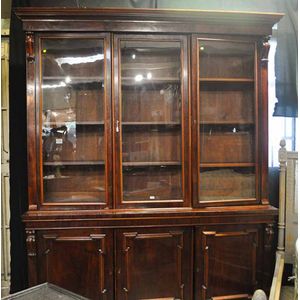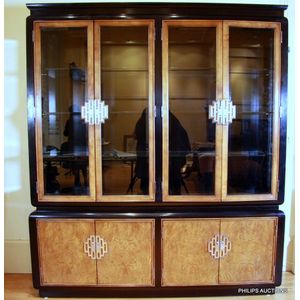Chinoiserie and Art Deco Inspired Display Cabinet
You must be a subscriber, and be logged in to view price and dealer details.
Subscribe Now to view actual auction price for this item
When you subscribe, you have the option of setting the currency in which to display prices to $Au, $US, $NZ or Stg.
- Ebonised - Timber that has been stained or lacquered black in imitation of ebony. The process has been used since the Renaissance, but is most commonly found in late 19th century furniture, sometimes gilded and turned in imitation of bamboo. Furniture with an ebonised finish is not currently in vogue, and this is reflected in the price for such pieces.
- Bevel / Chamfer - In furniture making, a chamfered corner refers to a technique used to create a smooth, angled edge on the corner of a piece of furniture. This is typically done by cutting away a small portion of the corner at an angle, typically 45 degrees, creating a diagonal edge, rather than a sharp 90-degree angle. This technique can be used on various parts of a piece of furniture such as table legs, drawer fronts, or door frames. Chamfering can add visual interest to a piece and can help to soften the overall look of a piece of furniture. It is often used in conjunction with other techniques, such as rounding edges or using contrasting wood species to create a more elegant, sophisticated look. Chamfering is a simple way to add a touch of elegance to a piece of furniture and it is a common technique used by furniture makers.
- Tier - One or more under-shelves of a table or cabinet.
- Chinoiserie - Furniture and decorative items decorated in imitation of a Western interpretation of the Chinese style. The Chinoiserie style first became popular in the late 17th century, though there were frequent revivals, notably by Chippendale (hence 'Chinese Chippendale') during the Regency period, and the Anglo-Japanese style in the second half of the 19th century.
The ubiquitous 'willow pattern' is the most common 'Chinese' theme used in porcelain, while on furniture the Chinoiserie style usually has black or red painted and lacquered decoration, though the hallmark of the furniture style is the use of fretwork in geometrical patterns, pagodas and other decorative forms.
Japonaiseries, as the name implies, are motifs in imitation of the Japanese taste.
See also "Chinese Chippendale". - Art Deco Period - The Art Deco period was a cultural movement that emerged in the 1920s and 1930s, and was characterized by its emphasis on modernism, luxury, and elegance. The name "Art Deco" comes from the Exposition Internationale des Arts Décoratifs et Industriels Modernes, a large exhibition held in Paris in 1925 that showcased the latest trends in decorative arts.
Art Deco was a reaction against the ornate and elaborate styles of the previous era, and reflected a new modern sensibility. It was characterized by streamlined, geometric shapes, bright colours, and the use of new materials such as chrome, glass, and Bakelite. Art Deco designers sought to create a sense of luxury and sophistication, often incorporating expensive materials such as ivory, marble, and rare woods.
Art Deco had a significant impact on a wide range of artistic fields, including architecture, fashion, graphic design, and interior design. Some of the most iconic examples of Art Deco architecture include the Empire State Building in New York City, the Hoover Building in London, and the Palais de Chaillot in Paris.
The Art Deco period came to an end in the 1940s, as World War II and changing cultural trends led to a shift in artistic styles. However, Art Deco remains an important influence on design and art, and continues to be celebrated for its modernist sensibility and glamorous aesthetic. - Cornice - The upper section of a high piece of furniture such as a bookcase, wardrobe or cabinet that sits immediately on the main structure. The cornice is usually decorated with a variety of architectural mouldings, worked either with a moulding plane or, from the later 19th century, by machine. The front and side of the cornice are mitred together, strengthened by glue blocks, and the back is generally a simple dovetailed rail to hold the structure together. Cornices are generally, though not always, fitted separately to the piece and are held in place either by screws sunk into the top board or by wooden corner blocks. A pediment may sit above the cornice, but sometimes the terms cornice and pediment are used interchangeably.
This item has been included into following indexes:
- display cabinets, material - walnut and burr walnut 205
- display cabinets, period, age or style
- furniture, period or style - Chinoiserie 263
- sideboards and cabinets - Chinoiserie 66
Visually similar items

Chinese rosewood elevated display cabinet with grape and vine leaf carving, the legs with carved ball claw ends, the top section with 3 glazed doors opening to glass shelves, the bottom with 3 drawers and 3 timber doors, divides into 2 parts for removal

Cedar bookcase with panelled doors and glazed upper section

A Victorian mahogany three door bookcase having cupboards below, 245 cm high, 198 cm wide, 48 cm deep

An English flame mahogany four door breakfront bookcase having four panelled doors below and four astragal glazed doors above. 240 cm high, 278 cm wide, 47 cm deep
